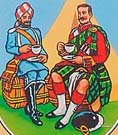Camp Coffee and political correctness
My grandmother used to drink Camp Coffee when I was growing up in Liverpool – usually with sterilized milk (who remembers that?) – horrible stuff! So I was intrigued to see the recent brouhaha following the manufacturer’s decision to change the label – as it was deemed to be politically incorrect.
When the inventors of Camp Coffee needed an image to market their new product 121 years ago, it seemed little could do the job better than a doughty Scottish warrior sitting down for a brew in a far-flung corner of empire.
To ensure Victorian consumers got the message that they were drinking the same caffeine concentrate designed to fortify soldiers subduing the colonies while campaigning (hence Camp), a kilted Gordon Highlander was shown being brought his drink by a Sikh manservant. Obviously, the relationship between the turbaned domestic and his moustachioed master - armed with a white porcelain cup and saucer - has changed to reflect attitudes towards the colonial era.
The new label now shows the Sikh soldier sitting beside his former boss - and with a cup and saucer of his own.
The story behind the label is intriguing as the Scot is supposed to be Major General Sir Hector Macdonald, scourge of Afghans, Boers and the Dervishes of Sudan.
He was the low-born soldier – son of a Scottish crofter - who turned down a Victoria Cross in favour of a commission, telling his superiors he would earn his medal later.
Known to millions as "Fighting Mac” he shot himself in the head in his bedroom in the Hotel Regina in Paris on 25 March 1903, minutes after reading a front-page story in the New York Herald suggesting he faced a "grave charge" – a Victorian euphemism for homosexuality..
It was he claimed he had gay affairs with a Boer prisoner of war and another while stationed in Belgium. He was also accused of a "habitual crime of misbehaviour with several schoolboys" in a railway carriage.
Macdonald was born in 1853 in Inverness, to a crofter and a dressmaker. He was an apprentice draper when he persuaded a recruiting sergeant from the Gordon Highlanders to accept him for training at the age of 17.
He became known as "Fighting Mac" for his exploits at the Battle of Omdurman, was wounded in the second Boer war. While serving in Afghanistan in 1879 as a regimental sergeant, he distinguished himself in battle to the extent that he was given the choice of a Victoria Cross, the ultimate military accolade, or a rare commission as an officer.
After fighting with such ferocity in the Boer War that an opposing general gave him back his sword when he was taken prisoner, Macdonald was credited with saving Lord Kitchener's imperial army at Omdurman - the Dervish stronghold where General Gordon of Khartoum was killed.
At the head of his brigade, Macdonald repelled a counter-offensive by 20,000 Dervishes with the loss of only 48 men and 382 wounded. A young Winston Churchill, reporting on the battle, wrote how, at one point in the battle, Macdonald called his officers around him and rebuked them for "having wheeled into line in anticipation of his order and requested them to drill more steadily".
McCormick Foods, which now owns the Camp Coffee brand and still manufactures it in Paisley, insisted yesterday that the decision to redesign its label was not a response to criticism from campaigners that it perpetuated racial stereotypes. A spokeswoman said: "All these evolutions have been purely driven by marketing considerations in order to make the logo and label designs more modern and attractive."
Whatever, the nature of his sexuality it should be noted that he did marry and two children.
Back to branding – the original label showed the Sikh hold a bottle of Camp Coffee on a tray. Actually, they got rid of the tray decades ago and the Sikh guy was left standing there as if he didn't know what to do with his free hand, which was clenched into an anxious little fist – frustrated sexual longing perhaps?
Now they are sitting in a companiable way enjoying a mutual cup of Camp Coffee – what we are to draw from this I am not sure. But that’s what I call a brand history!





1 comment:
OK this is by far the funniest - and especially when reading it in New York, with 51st Street as a backdrop.
I am now desperate to see the interim label -a ll I can remember is the 'tray' era....
Post a Comment